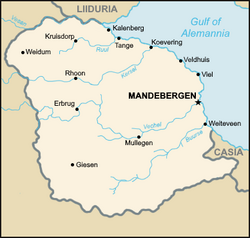Rodavia
This article is incomplete because it is pending further input from participants, or it is a work-in-progress by one author. Please comment on this article's talk page to share your input, comments and questions. Note: To contribute to this article, you may need to seek help from the author(s) of this page. |
Kingdom of Rodavia Koninkrijk Stijerland (Rodavian) | |
|---|---|
| Motto: "Vrede, welvaart, frijheid" ("Peace, prosperity, freedom") | |
| Anthem: "Stijerlandse mars" ("Rodavian march") | |
 | |
| Capital and largest city | Mandebergen |
| Official languages | Rodavian |
| Recognised regional languages | Liidurian |
| Ethnic groups | 88.5% Rodavian 4.9% Other Asuran –– 3.7% Liidurian 4.7% Cataian 1.1% Majulan 0.8% Other |
| Demonym(s) | Rodavian |
| Government | Unitary parliamentary constitutional monarchy |
• King | Louis III |
• Premier | Klaas-Jan Gerner |
| Legislature | Parliament |
| Chamber of State | |
| National Assembly | |
| Population | |
• 2020 estimate | 46,003,162 |
• 2018 census | 45,817,299 |
| GDP (PPP) | 2020 estimate |
• Total | $2.05 trillion |
• Per capita | $44,668 |
| GDP (nominal) | 2020 estimate |
• Total | $2.01 trillion |
• Per capita | $43,781 |
| Gini (2019) | 39.7 medium |
| HDI (2019) | 0.904 very high |
| Currency | Rodavian graner (RDG) |
Rodavia (/'roʊdeɪvi:ɑ/; Rodavian: Stijerland, ['stɑi:ərlɑnt]), officially the Kingdom of Rodavia (Rodavian: Koninkrijk van Stijerland) is a country on the Gulf of Alemannia in eastern Asura. It borders Liiduria to the north, X to the south and X to the west, as well as sharing a maritime border with Casia. With a population of 46 million, Rodavia is one of Asura's largest and most populous states. Its capital and largest city is Mandebergen, while other urban centres include Koevering, Viel and Mullegen.
Humans have inhabited Rodavia for nearly 7000 years, with stone tools found in northern Rodavia now linked to the Kersel culture, Rodavia's earliest inhabitants. The Waarland mountains in the west of the country kept later Rodavians isolated from western Asura until the rise of the Pergalean Empire, when the first trade routes were established with the west around 100 AD, and the first written documentation of the peoples of Rodavia, named Rhaedii by the Pergaleans, from raeda, a wagon used by the Rodavians for transport. Kingdoms and duchies emerged around in the 9th century, but faced early competition from the states of Liiduria in the north and Casia in the south, as well as maritime influence from the Sadamic League later on. Philip the Brave would unify much of northern Rodavia in the 14th century under the Kingdom of the Ruul, establishing the Rodavian-Liidurian border at the Vesan river. The Kingdom of the Ruul would be the main force behind Rodavian unification in 1626.
The War of the Rubies in the 1680s saw Rodavia gain toll-free access to the Gulf of Alemannia, the region of Piriimaa and the port city of Sønderburg in Lhedwin, where much of Rodavia's colonial ambitions would be based from. Rodavian control over Piriimaa would be characterised by mass killings, relocations and deportions as Rodavia attempted to replace the ethnic Liidurian population before a successful rebellion aided by Liidurian intervention would see the region returned in 1818. Rodavia entered a period of significant scientific and social progress in the mid-to-late 19th century, where significant technological innovations as well as the creation of the Premier of Rodavia in 1878 would cement Rodavia's position as a forefront Asuran power. Rodavia fought in the Great Asuran War in the 1900s alongside Camria and Miricia, eventually earning Rodavia economic reparations from Casia, which influenced its post-war economic boom in the 1910s. Most of its overseas holdings were relinquished throughout the 1920s and 1930s as the economic burden of their maintenance grew. Rodavia reformed into an open parliamentary democracy in 1964, with the monarch adopting a figurehead role.
Rodavia is a long-standing democratic power, a founding member of the Cyningburgh Pact for International Security and the Asuran Council, and a permanant member of the Security Council of the Congress of Nations. Rodavia ranks highly in human development, economic freedoms, democratic indexes, overall happiness and quality of education, and is a highly developed country with a GDP per capita of $44,000, one of the world's highest for a state of over 5 million people. It receives around 45 million tourists per year, and tourism is a significant industry within the country. It is also a significant importer and exporter goods, particularly within the AC.

